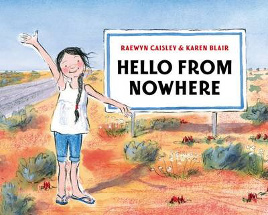Hello from Nowhere by Raewyn Caisley and Karen Blair

Viking/Penguin, 2014. ISBN 9780670075003
(Age: K-3) Far out in the middle of nowhere, the back of beyond,
even beyond the black stump lives Eve - and she thinks it is the
best place in the world to live. Even though it is so desolate and
distant, she's never lonely because there are all sorts of creatures
who keep her company and she meets plenty of people who come into
the family's roadhouse. And even when there is no one there it
doesn't matter because she has time and space to run or lie down and
just look at the sky and feel the magic of nature all around her.
But there is one person she really wants to see-her Nan. Can she
persuade her to come for a visit?
This is a joyful book that celebrates how much pleasure there can be
in the simplest of lives and the starkest of surroundings. Eve can't
rely on screen-based connections and organised activities for her
entertainment - she has to rely on herself. And for me, this is the
power of the story. Every time school holidays roll around parents
hear the 'I'm bored' refrain and are bombarded with advertisements
about ways to amuse and entertain. But there is a whisper that is
growing louder that kids need to be bored if they are to develop
their imaginations, their resilience and their ability to relax and
do nothing. Not every minute of every day has to be crammed with
something. Hello from Nowhere is the perfect starting point for
getting younger readers (and older) to consider this and stop and
think about their surroundings. What is there already in their
environment waiting to be discovered? If, like Eve, they moved from
city to country, would they have the wherewithal to discover the
delights of such a different situation? In the US particularly,
schools celebrate Screen-free
Week (it used to be Turn Off TV Week) so if this were also a
major focus here, what would the children do to entertain
themselves?
There are many challenges that could be set . . .
Be like Eve and write to someone persuading them to visit by
identifying all the things you could do together, none of which is
to involve organised entertainment but each of which is to tempt the
person by being something they probably wouldn't experience where
they are.
Give students a budget of $50 and have them investigate and devise a
timetable of entertainment for the next school holidays which
includes a limit on the amount of screen-time. Publish the
suggestions in your school's newsletter for parents to consider.
Have students investigate how their peers entertain themselves, then
analyse the data and publish the findings.
Investigate ways of adding extra-curricular activities to what the
school offers - perhaps creating a frog-friendly garden or starting
an interest-based group - and discovering how these might be
actually put in place.
Karen Blair's illustrations also depict the isolation and beauty of
Eve's circumstances - when was the last time you shared a waterhole
with camels? - and that leads on to a whole new field of
investigation about looking at landscapes and examining and creating
artworks that depict their diversity.
The best picture books are a synergy of text and illustrations and
have many layers which allow them to be shared again and again and
again, with something new to be discovered each time. This is one of
those.
Barbara Braxton